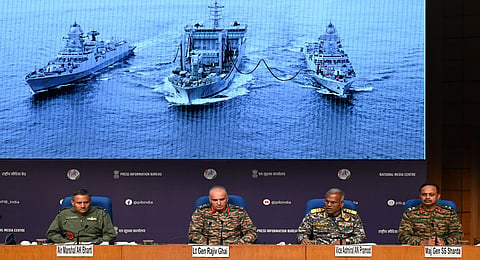

During Operation Sindoor, while rabid television anchors were replaying fake videos, breathlessly discussing dogfights that never happened and lying about Indian Navy bombing Karachi, the real devastating victory came not from the roar of warplanes but from the flow of waters. India’s decision to suspend the flow of the Indus to Pakistan is not just a policy move. It is a tectonic shift in the subcontinent’s balance of power; one with consequences far deeper than the craters left by airstrikes. For decades, India, the upper riparian state, abided by the 1960 Indus Waters Treaty (IWT), a Cold War-era relic negotiated with the help of the World Bank that gifted Pakistan 80 per cent of the waters of the Indus, Ravi, Sutlej, and Beas. Even during wars, when Indian soldiers returned wrapped in tricolour, the rivers flowed. India kept its word. Pakistan sent jihadis; we sent water.
This time, India rewrote the rules of engagement, not with fighter jets, but with geography. By moving to suspend rivers from entering Pakistan, India made a strategic move: it reminded Pakistan of what real helplessness looks like. You can build a nuke. You can train a terrorist. But you can’t summon a river. Nearly 90 per cent of Pakistan’s crops depend on the Indus Basin. Disrupt the water flow, you unleash famine, joblessness, and unrest in a fragile, military-dominated economy. When India bombs a terror camp, Pakistan finds a tame camera crew to shoot its prime minister examining wreckage of a terror group’s headquarters. When India stops rivers, there is nothing to hit back at: no fighter jet to shoot, no border post to shell. Pakistan’s generals understand airspace. They don’t understand aquifers. Their defence budget buys tanks, not fund tubewells. While they staged tactical theatrics for domestic consumption after Balakot, India moved engineers, tunnels, and irrigation projects into place.
Islamabad’s response? Pleas to international courts. Appeals to treaty morality. Suddenly, the very legal frameworks it once mocked became lifelines. No treaty in the world forces a nation to supply water to the very hand that arms its assassins. But here lies a complication, and a warning. If rivers are weapons, China, the upper riparian of the Brahmaputra (or Yarlung Tsangpo), has for years quietly tested its hydrological leverage against India. Dams, diversions, data withholding; each tactic would be a veiled reminder that the Himalayas feed not just nationalism, but negotiation, too. In the event of a full-scale standoff, China could squeeze India’s northeast by choking the Brahmaputra. New Delhi has made its boldest move in decades, but it must prepare for Beijing’s countermove, even if there is no apparent sign. The real theatre of South Asia’s future isn’t in Islamabad or New Delhi, but in the high-altitude ice fields of the Tibetan Plateau, and the floodplains that lie downstream. But here’s the difference. India is a democracy forced to play fair for too long. China is an autocracy with no interest in a moral high ground. The only way to neutralise Chinese hydropower threats is to double down on domestic water security: build, store, redirect, innovate. And above all, be unpredictable.
The next great war in South Asia, perhaps in the world, will not be about borders. It will be about water. And India, for the first time in decades, is wielding that most ancient of weapons: control over nature itself. In doing so, it has turned a defensive treaty into an offensive doctrine. Pakistan is helpless, and China is watching. Because when rivers change direction, so does history.